Crawling Back: Amazing Spider-Man #13 Review (The Sinister Six, Part 5)
A classic villain deserves a better debut in an issue that has an interesting premise but is executed awkwardly
—by Nathan on July 21, 2025—
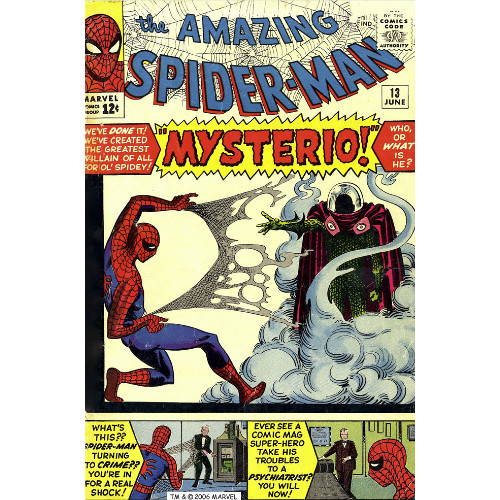
In my recent review of Fantastic Four #3, I compared that issue's villain, the hypnotist known as the Miracle Man, to another showman-turned-supervillain, the enigmatic Mysterio. Specifically, I referred to the Miracle Man as "a poor man's Mysterio," a guy whose only ability was placing folks under his hypnotic trance. Once that jig was up, he was basically useless.
The man known as Mysterio has gone by many names over the years–Quentin Beck, Dr. Ludwig Rinehart, Nicholas Macabes–and the identity has been assumed by figures other than Beck. He's been a stalwart member of the Sinister Six (primarily why I'm reviewing his first appearance today), belonging to not only the team's first roster, but subsequent incarnations in the 90s and 2000s. He's a classic Stan Lee and Steve Ditko creation, and though I would argue some of his best stories take place outside Spidey's comic corner–"Daredevil: Guardian Devil" and the original Old Man Logan come to mind–he's always been a staunch Spidey adversary. He's not one of those wishy-washy guys who fight Spidey for a bit, then tussle with the Hulk, then go back to Spidey, then fight Daredevil…
Anyway.
Fans familiar with Jake Gyllenhaal's portrayal of the villain in Spider-Man: Far From Home will know the dude's deal already. He's a tech wizard playing the long con, setting himself up as a hero while fooling the puny minds of all the oblivious people around him. Longtime comic fans may not have been tricked when Gyllenhaal's version of Quentin Beck popped up on screen, but I can see where readers picking up this issue in 1964 may have been more intrigued by the mystery-o developed inside…
"The Menace of…Mysterio"
Writer: Stan Lee
Penciler: Steve Ditko
Inker: Steve Ditko
Colorist: Stan Goldberg
Letterer: Artie Simek
Issue: Amazing Spider-Man #13
Issue Publication Date: June 1964
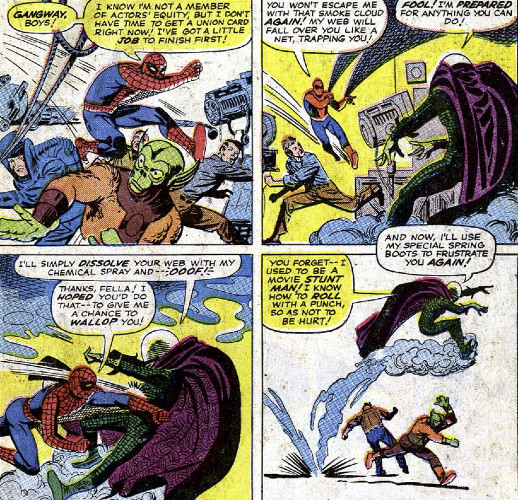
...though I guess the cover kinda spoils the mystery-o, doesn't it?
There it is, in all caps, Stan Lee and Company touting how they've "CREATED THE GREATEST VILLAIN OF ALL FOR OL' SPIDEY!" Lee, known for his carnival barker method of hyping himself up to readers, really wants to grab you by the shoulders and not let you go. The Vulture? Doc Ock? Electro? Patsies compared to this Mysterio guy. His head covered by a glass dome, his form wreathed in smoke, his outstretched hand dissolving Spidey's webbing without touching it, Mysterio certainly does appear to be a great addition to the Wall-Crawler's ever-growing rogues gallery. Yet for a villain based on trickery, it's surprising he's called out immediately on the cover. It doesn't really tickle the interest the same way the statements below Mysterio do. The idea of Spidey committing a crime or seeking psychiatric help make for more compelling reasons to read this issue than the villain's debut, in my estimation.
I had completely forgotten the scene where Spidey visits a psychiatrist's office, our hero compelled when "Spider-Man" begins committing crimes. Peter, worried about the possibility he may be performing robberies subconsciously, halfway wonders if he may be "going mad–doing things I don't remember the next morning?!!" For a scene trumpeted on the cover, the visit to the "shrink" is incredibly brief, Spidey soon realizing he may accidentally divulge his identity to the doctor while the psychiatrist is more interested in making a patient out of this (in)famous superhero. These are not the most astute observations made of mental illness or the psychiatric profession–I think there's merit to Peter's concern regarding his mental health as a teenage superhero bitten by a radioactive insect, but the whole bit is brushed aside rather quickly.
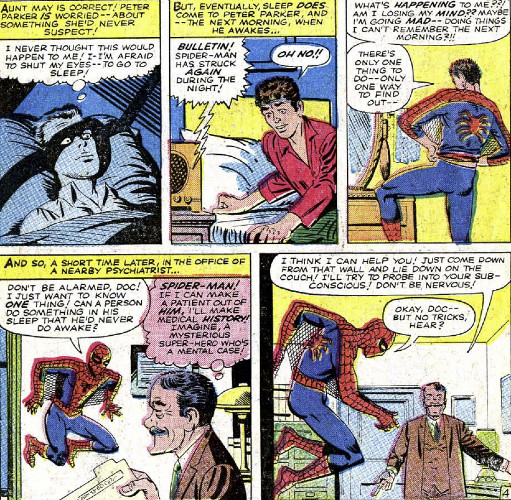
Yet, as fans soon learn, Peter need not have worried: a more sinister culprit is behind this criminal Spidey's mask when he isn't wearing a fishbowl. Mysterio is certainly unique among his peers. He doesn't possess superpowers like the Sandman, the increased strength of Kraven or the Green Goblin, or even unique technology like Doc Ock or the Vulture. He's a regular guy, a former stuntman and special effects artist, who builds gadgets to face Spidey. He seems like he'd be a total schmuck against our hero, but I guess that's the beauty of storytelling: if you want your villain to pose a viable threat to our hero, however ludicrous it may seem, you'll make it happen.
Mysterio's DIY version of supervillainy gives Peter the opportunity to use his brain to fight this guy, determining how best to find workarounds for the villain's technology (thanks, in large part, to the blabbermouth telling our hero about the tools Mysterio has developed). Like beating Sandman with a vacuum (not literally, geez…) or developing a formula to change the Lizard back into Curt Connors, Spidey finds his wit serves him better than just his strength. The fights are fun, Ditko finding clever ways to use Mysterio's "abilities" while the pair fight atop a bridge and later constructing a sci-fi movie set for the two to ping-pong around, and the skirmishes allow the issue a classic structure, with Spidey learning from his earlier defeat to give his latest foe a Mysteri-KO.
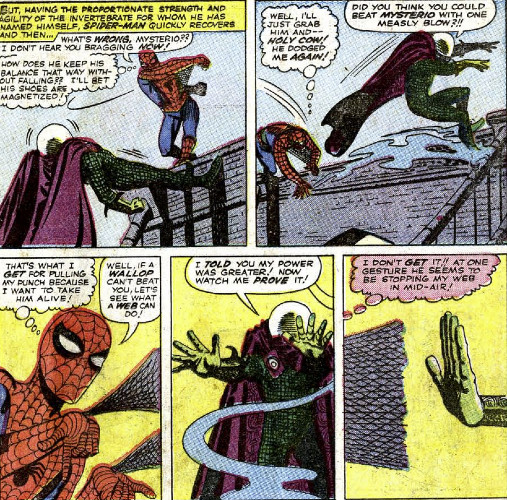
Within the context of the narrative, we are given some clever plotting. The issue opens with Mysterio committing a crime as Spidey, Ditko surreptitiously hiding any possible gadgetry to make it appear Spidey is truly the criminal. A web gun hidden by the imposter's body, a parachute made to look like webbing, suction devices hidden within the costume…some of Spidey's abilities are easy to duplicate, and some of the fun of the issue comes from Mysterio later revealing how he copied those powers. His is a very practical approach to crime, using his knowledge and experience to find a scientific solution to besting Spidey as a stand-in for his lack of actual power.
Though the reader may not be overly fooled by the story, our characters are, and if you give them some slack, you can see how they'd be bamboozled. More importantly, it's the tension Mysterio's actions create which drive the narrative forward. Because of Mysterio's crimes, Flash Thompson is forced to defend his favorite superhero against the other students of Midtown High, the general public's suspicions of the teenage hero are elevated further, J. Jonah Jameson chortles with glee, and Peter Parker is given over to the occasional paroxysm of panic in and out of costume. Peter's wrestling makes for nice conflict within himself, as he waffles between his own confidence ("I know I didn't commit that crime!") and the doubts which plague his young mind.
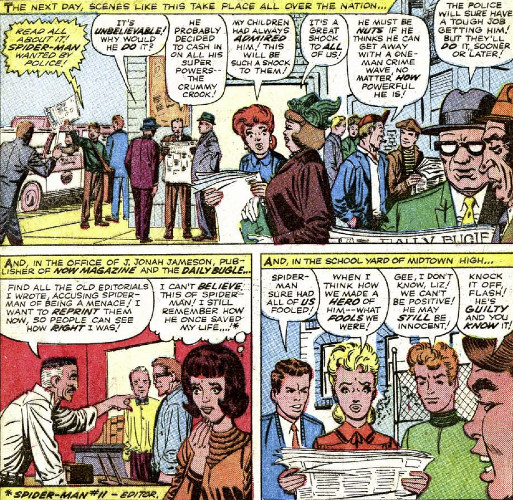
Unfortunately for our costumed teenager, Peter's supporting cast members don't help much with these doubts at all! Lee seems to want to make the people around Peter sympathetic to his feelings, yet he presents this in the silliest possible manner. When Aunt May notices Peter's distracted demeanor, she asks, "You're not worried because our savings account is almost gone, and it's getting harder to pay the mortgage each month, are you?"
Well, if he wasn't before, he certainly is now, May!
And just a page later, Betty Brant notices Peter's moodiness and assumes he's"probably worried" because he "hasn't sold any news photos to Mr. Jameson lately!" Yeah, thanks for that, too, Betty! With friends like these, I tell ya…
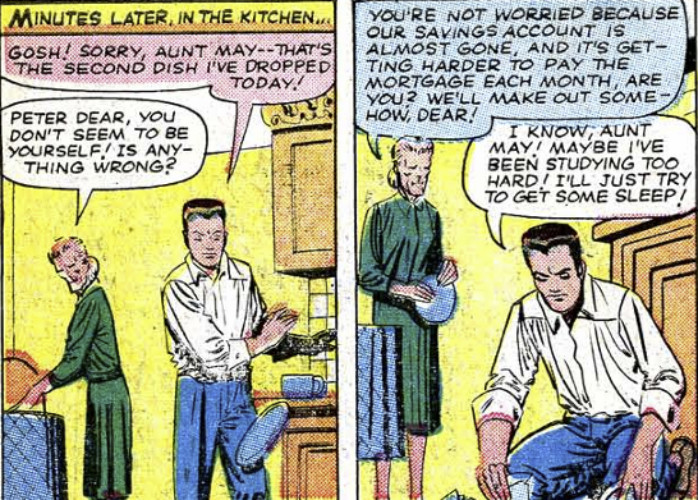
"Is anything wrong?" Liz Allen later asks Peter, the one person who's actively curious about the genuine reason behind Peter's downbeat visage…when she isn't concerned about how Peter likes her hair. Peter's response is a bit of a crude brush-off ("If it gets any better, I'll shoot myself!"), but at least Liz gets points for noticing. Small bits like this from Liz are things I never paid much attention to, but they make me believe they were subtle references by Lee and Ditko as to Liz's interest in the young man, which she'd reveal at a later time. So good on Liz for being the one person paying enough attention to Peter without needing to draw her own conclusions first. I get the other characters are weaving in some exposition, reminding us of the Parker family's financial woes, but these moments are approached with about as much subtlety as the front cover proclaiming who the villain of the piece is.
There's a reason he's named "Mysterio," guys! Come on!
Anyway.
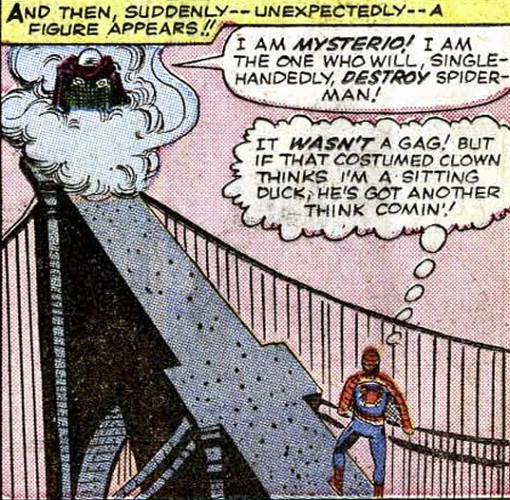
Conceptually, the man with the fishbowl helmet works well, especially if you can forget that the Chameleon had pulled the same "discredit Spider-Man" trick eight issues earlier and that the very next issue, also taking place in part on a movie set, would feature the more dramatic debut of another green-and-purple arch-enemy. Ditko capably hides the villain's tricks, and his backstory lends him the credence and capability to pull his gags on an easily persuaded public (save for that Thompson boy!). In execution, though Ditko develops some highly engaging action sequences, Lee doesn't quite make the villain's debut as memorable as other antagonists. Characters feel written because Lee just wants them written a certain way–if Aunt May and Betty are awkwardly sympathetic, so be it; if Spidey is easily trounced by a guy with springy boots, then there you go; if Peter determines for a second he needs to visit a psychiatrist's office before tabling the whole idea, then I guess we'll do that too.
These pieces guide the plot in the direction Lee intends for it to go, sure, but several bits surrounding our main villain come across a little silly or rushed and are bludgeoned with the bluntness Lee's writing provides. Ditko's "special effects" are the winner here, helping prop up Quentin Beck's first appearance in places where the script feels middling and cheesy. Maybe that's the real trick after all: in a story about a villain using smoke and mirrors, maybe we're supposed to be tricked into believing this debut is better than it really is.